
Back in 2002 I got a mail from Rick Reed asking me if I'd
like a TRS80 (often called 'Trash80') Model 1. Of course I would! Being slightly
unemployed at the time meant I could drive across the Pennines to pick it up on a sunny
day in February.
I wasn't expecting the amount of stuff there was! Everything was
boxed - Model 1 itself, Monitor, Expansion Interface, Floppy drives, plus there
was a box of disks, 2 boxes of tapes and 2 big boxes of documentation.....smart!
Thanks Rick!
Unfortunately the machine wasn't well and I didn't have an Oscilloscope
to troubleshoot any further than I already had with help from Tony Duell and
the regulars on the comp.sys.tandy newsgroup. It behaved as expected without
ROMs so the CPU was running and main memory was happy, so the problem must've been
either the ROMs themselves or a fault on the data lines going to them.....troubleshooting
those required extra kit so until I can get some spare ROMs the machine will
have to stay unwell :(
The machine had been upgraded at time of purchase, according to
the receipt, so it has Level II BASIC (not the Level I 'Tiny BASIC' which only
had 3 error messages - 'SORRY', 'HOW' and 'WHAT'...hehe) and a lower case modification
that added an extra screen RAM chip and some wirewrap wiring.
These are pictures of the machine from when I got it.
Pictures
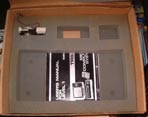 | 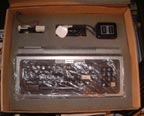 |  | 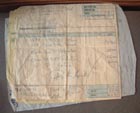 |
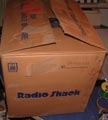 | 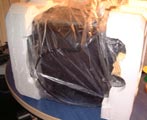 | 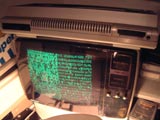 | 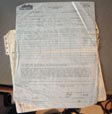 |
 |  |  |  |
2017 Update
Fixing up my TRS80 Model 4P recently reminded me I'd never got round to
fixing this machine so out it came once I'd located and dug out all the required bits. 15
years on I'd moved house 4 times so it surprised me that I knew where everything was. My EEPROM
burner was ready to make new ROMs since that's what we had decided back in '02, but the 12K
of ROM is split between an 8K 2364 and a 4K 2332, neither of which are available or even
programmable with even a 20 year old programmer.
This meant I'd have to swap in a 2532 which is pin compatible but needs an
extra modification for the 3rd chip select line in use. The 2364 can only be replaced with
a 2764 which has 4 extra pins so not only would I have to make an adapter I'd also have
to adapt the adapter for the 3rd chip select!
By pulling the ROM select jumper block (Z71) and the RAM select jumper block (Z3) you can easily
see if there's a ROM or RAM problem - a screen full of @9 suggests ROM errors and
a screen full of @S suggests RAM errors. I got both so I pulled the 8 DRAM chips
and ran them through a tester I'd made from a scrap ZX Spectrum board (thanks to Dave at
Tynemouth Software for the hint) and one was dead. Replace with a NOS one and I got life!
Well. I got sort-of life. Instead of MEM SIZE? I got OEO SIZE= which meant
a single bit in the video RAM was stuck high - 'M' is 01001101 in binary and 'O' is 01001111. Video RAM is made of 7 chips
representing bits 0-5 and 7-8 with bit 6 being derived from an OR operation between bits 5 and 7 meaning the machine can only display upper case. However
this machine has a lower case mod which consists of an 8th RAM chip to provide bit 6 utilising some spare gates on the support
chips and a new character generator. The 8th chip piggybacks one of the existing 7, in my case Z46 which represents bit 2 of each character. My fault was bit 1
so I swapped Z47 next to it and hey presto I get MEM SIZE?. Excellent.
A similar RAM test was done on the expansion unit once the buzzing PSU was deemed OK and 2 dead chips were swapped
in that too. PRINT MEM from BASIC showed 48K. The Cumana twin floppy drive only needed a head clean! Time to go
through all the disks Rick gave me with the machine :D
2017 Pictures
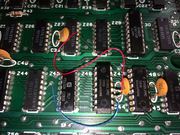 | 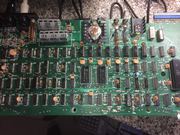 | 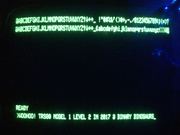 | 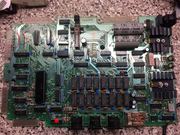 |
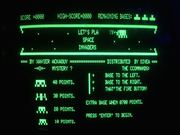 | 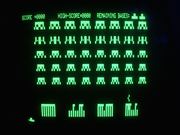 | 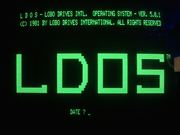 | 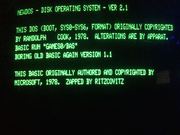 |
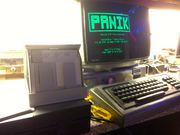 | 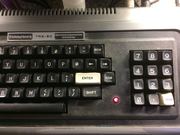 | 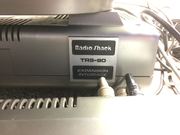 | 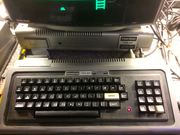 |